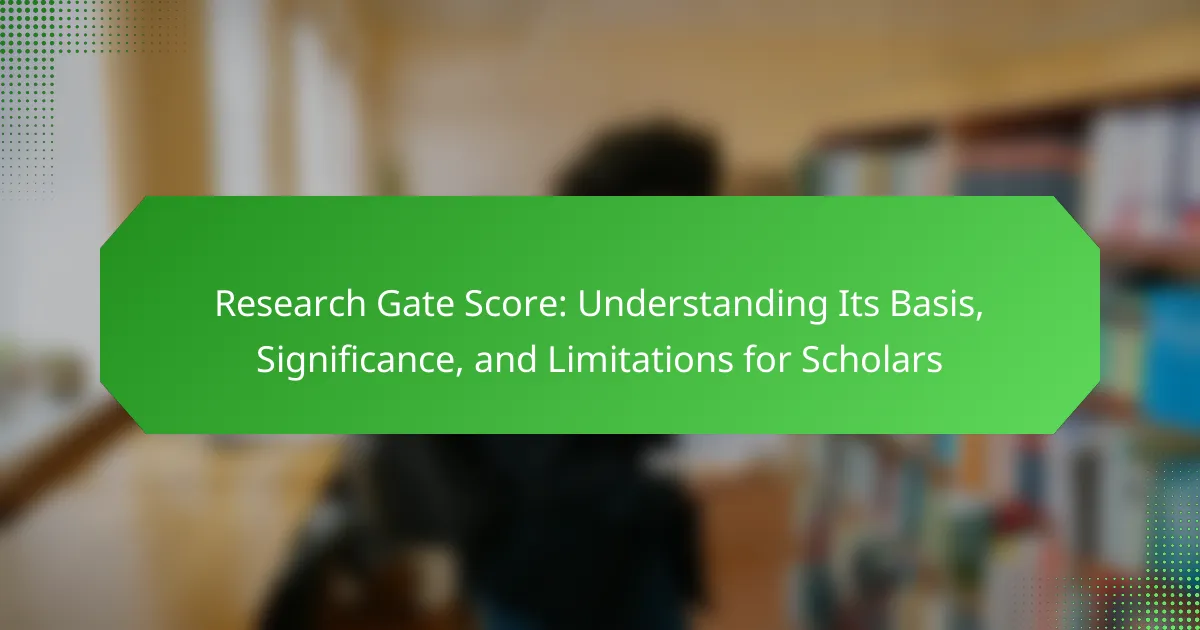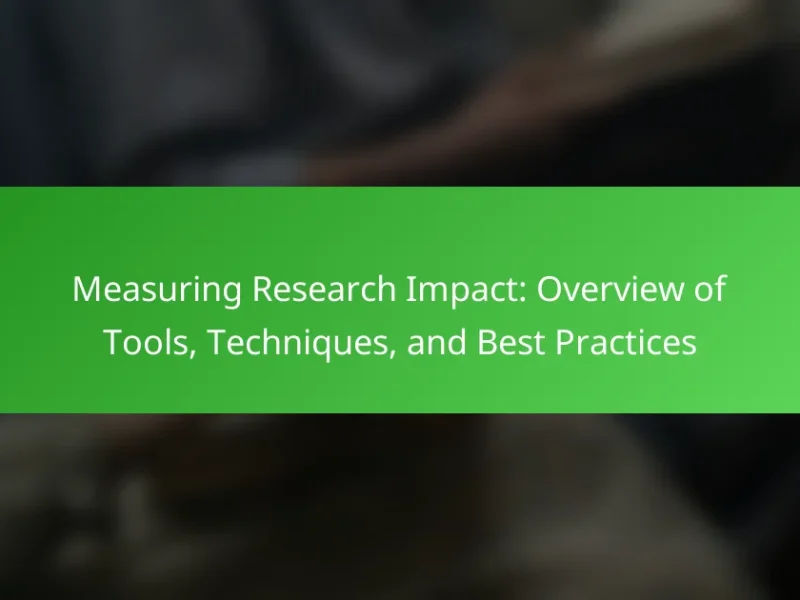The Research Gate Score is a key metric that measures the impact and engagement of a researcher’s work on the ResearchGate platform. This score is derived from various factors, including the number of publications, citations, and the researcher’s activity on the platform. The article explores the basis of the Research Gate Score, its significance for scholars in assessing their visibility and influence within the academic community, and the limitations that accompany this metric. By understanding these elements, researchers can better navigate their academic presence and the implications of their Research Gate Score.

What is the Research Gate Score?
The Research Gate Score is a metric that quantifies the impact and engagement of a researcher’s work on the ResearchGate platform. It is calculated based on various factors, including the number of publications, citations, and the activity of the researcher within the platform. This score helps researchers gauge their visibility and influence in the academic community. A higher score indicates greater engagement and impact. ResearchGate uses algorithms to update this score regularly, reflecting changes in a researcher’s activity and the reception of their work.
How is the Research Gate Score calculated?
The Research Gate Score is calculated based on the engagement and impact of a researcher’s publications. It considers factors such as the number of citations, the quality of publications, and the interactions with other researchers. Each publication is assessed for its citation count and the influence it has on the research community. Additionally, the score is influenced by the researcher’s collaborations and the visibility of their work. The score is updated regularly to reflect ongoing changes in citation metrics and research activity. This calculation aims to provide a comprehensive view of a researcher’s contributions and influence in their field.
What metrics contribute to the Research Gate Score?
The Research Gate Score is influenced by several key metrics. These include the number of publications, the number of citations received, and the engagement with research outputs. The score also considers the impact of the publications, which is measured through citation metrics. Additionally, the quality of the journals in which the research is published affects the score. Research Gate calculates the score based on the activity and interaction on the platform, such as questions answered and contributions to discussions. These metrics collectively determine a researcher’s visibility and influence within the academic community.
How does publication impact the Research Gate Score?
Publication significantly impacts the Research Gate Score. The score is influenced by the number of publications a researcher has. Each publication contributes to the overall visibility and engagement metrics. Higher publication counts typically lead to increased citations and downloads. Research Gate calculates the score based on these engagement metrics. Therefore, more publications can enhance a researcher’s score. This correlation is evident as researchers with extensive publication records often have higher scores.
Why is the Research Gate Score significant for scholars?
The Research Gate Score is significant for scholars as it reflects their research impact and engagement. This score is calculated based on citations, publications, and interactions on the ResearchGate platform. A higher score indicates a stronger academic presence and influence within the scholarly community. Scholars with a notable Research Gate Score may attract more collaboration opportunities. They might also enhance their visibility to potential employers and funding bodies. Studies show that a robust Research Gate Score correlates with increased citation rates. This makes it a valuable metric for assessing research performance. Therefore, scholars often strive to improve their score to bolster their academic reputation.
What role does the Research Gate Score play in academic reputation?
The Research Gate Score influences academic reputation by quantifying a researcher’s impact. It is derived from various metrics, including publications and citations. A higher score often correlates with greater visibility in the academic community. Researchers with elevated scores may attract more collaboration opportunities. Institutions may also view the score as an indicator of research quality. This score can enhance a researcher’s credibility and standing among peers. Additionally, it may affect funding opportunities and job prospects. Studies indicate that researchers with higher scores are more likely to be recognized in their fields.
How can the Research Gate Score influence funding opportunities?
The Research Gate Score can significantly influence funding opportunities for researchers. A higher Research Gate Score indicates a greater impact of a researcher’s work. Funding bodies often consider this score as a measure of a researcher’s credibility and influence in their field. Researchers with higher scores may attract more attention from grant committees. This can lead to increased chances of securing funding. Additionally, a strong Research Gate Score can enhance collaboration opportunities. Collaborations often lead to joint funding applications, further increasing the potential for financial support. Therefore, maintaining a robust Research Gate Score is advantageous for researchers seeking funding.
What limitations are associated with the Research Gate Score?
The Research Gate Score has several limitations. It primarily reflects engagement rather than the quality of research. The score can be influenced by self-reported data, which may not be reliable. Additionally, it does not account for the context of research contributions. The score can vary significantly across disciplines, making comparisons misleading. Furthermore, it may not adequately represent researchers with niche expertise. The algorithm used to calculate the score is not transparent, leading to potential biases. Lastly, the score does not consider collaborative work effectively, which can undervalue team contributions.
What are the criticisms regarding the accuracy of the Research Gate Score?
The Research Gate Score has faced criticism for its accuracy and reliability. Critics argue that the score does not accurately reflect a researcher’s impact. The score is based on various metrics, including publication counts and citations. However, it can be influenced by self-reported data, leading to potential inaccuracies. Additionally, the score may not account for the quality of the journals where research is published. Some researchers point out that it favors certain disciplines over others. This disparity can skew the perceived contributions of researchers in less represented fields. Overall, the criticisms highlight concerns about the validity and objectivity of the Research Gate Score as a measure of scholarly impact.
How does the Research Gate Score differ from other academic metrics?
The Research Gate Score measures an author’s impact based on their publications and engagement on the ResearchGate platform. Unlike traditional metrics, it incorporates both citation counts and the activity level of researchers. This score reflects not only the academic influence but also the social interactions within the ResearchGate community. Other academic metrics, such as the h-index, primarily focus on citation counts without considering social engagement. The Research Gate Score also updates regularly, providing a dynamic view of a researcher’s influence, while some metrics remain static. This unique approach allows for a more comprehensive assessment of a researcher’s contributions and visibility in their field.
How can scholars improve their Research Gate Score?
Scholars can improve their Research Gate Score by increasing their publication output and enhancing their visibility. Regularly publishing high-quality research articles boosts the score significantly. Engaging with the academic community through networking and collaborations can also lead to more citations. Actively sharing research findings on ResearchGate increases exposure and encourages downloads. Responding to inquiries and participating in discussions on the platform fosters engagement. Additionally, optimizing the research profile with a complete list of publications and relevant keywords enhances discoverability. Research shows that profiles with comprehensive information attract more attention and citations, positively impacting scores.
What strategies can be employed to enhance publication visibility?
Utilizing targeted keywords in titles and abstracts enhances publication visibility. Incorporating relevant terms improves search engine optimization. Engaging with the academic community through social media platforms increases exposure. Sharing publications on ResearchGate can attract a wider audience. Collaborating with co-authors can boost reach and credibility. Participating in academic conferences raises awareness of research work. Regularly updating profiles on academic platforms keeps visibility high. Building a personal brand through consistent engagement can also enhance recognition.
How important is collaboration in boosting the Research Gate Score?
Collaboration is crucial for boosting the Research Gate Score. It enhances visibility and credibility among peers. Collaborative research often leads to higher citation rates. Higher citations contribute positively to the Research Gate Score. Studies indicate that collaborative authorship increases publication impact. This impact reflects in the overall score. Therefore, engaging in collaborative projects is beneficial for researchers aiming to improve their scores.
What are the best practices for utilizing the Research Gate Score effectively?
To utilize the Research Gate Score effectively, researchers should regularly update their profiles with new publications. This ensures that the score reflects the most current research contributions. Engaging with the community by answering questions and providing feedback can enhance visibility and interactions. Collaborating with other researchers can also lead to increased citations, thereby improving the score. Sharing research outputs and data sets can attract more attention and engagement. Monitoring trends in the score can help identify areas for improvement. Lastly, leveraging the score in grant applications and academic discussions can highlight research impact.
How can scholars navigate the limitations of the Research Gate Score?
Scholars can navigate the limitations of the Research Gate Score by diversifying their publication strategies. They should publish in a variety of reputable journals to enhance visibility. Engaging with the academic community through conferences can also improve their score. Actively sharing research outputs on multiple platforms increases reach and engagement. Collaborating with other researchers can lead to co-authored publications, boosting citation potential. Furthermore, scholars should focus on quality over quantity in their research contributions. Regularly updating their Research Gate profile ensures accurate representation of their work. These strategies help address the score’s limitations while enhancing academic presence.
The Research Gate Score is a metric that quantifies a researcher’s impact and engagement on the ResearchGate platform, calculated through factors such as publications, citations, and platform activity. This score is significant for scholars as it reflects their academic visibility and influence, potentially affecting collaboration opportunities and funding prospects. The article will explore how the Research Gate Score is calculated, the key metrics contributing to it, its significance and limitations, and strategies for scholars to enhance their scores while navigating its challenges. Additionally, it will compare the Research Gate Score to other academic metrics, highlighting its unique aspects and implications for researchers.


